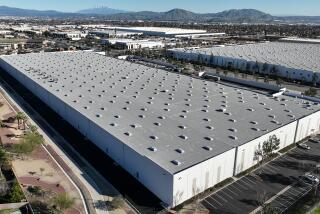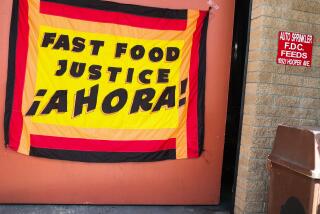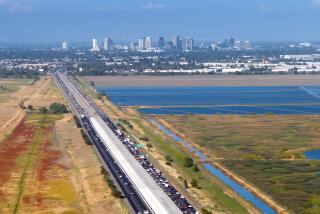Support Growing for Rush-Hour Truck Ban
Banning trucks from crowded Los Angeles freeways during rush hours may be an idea whose time has arrived, judging by movements afoot in the San Fernando Valley and elsewhere.
In the past six months, government officials have floated five proposals for such restrictions, including suggested bans on trucks during peak hours on the Golden State and Ventura freeways in the Valley.
Transportation planners say such restrictions could sharply reduce congestion on many freeways and streets. Three study committees have been formed and another is expected to begin work soon developing the various plans.
The proposals have the support of Mayor Tom Bradley, several key Los Angeles City Council members and the five county supervisors, all of whom have gone on record in favor of some sort of restrictions on trucks.
Despite all the support, however, it remains uncertain whether any of the plans can overcome the many hurdles that lie in their paths.
Chief among the barriers is a federal law requiring traffic planners to provide a comparable alternate route for any section of federally funded road that is made off limits to trucks.
Alternate Routes
In two cases, planners have identified alternate routes but are uncertain whether they will be deemed adequate by the Federal Highway Administration.
Another unknown factor is the trucking industry, which generally opposes truck bans but remains willing to study the issue.
Planners say they are not sure what would happen if the trucking industry decides such bans are a threat to their livelihood and launches a vigorous campaign against the movement to ban trucks.
Planners also are unsure whether public opposition to suggested alternate routes will stymie proposed truck bans.
All five proposals have as their antecedent the successful voluntary truck ban that is widely credited with helping create free-flowing traffic during the 1984 Olympics.
During the two-week Games, trucks were lured from the freeways in peak hours by the temporary lifting of ordinances prohibiting operators from picking up and delivering goods before 7 a.m.
‘The Streets Worked’
“Everyone recalls how marvelous it was when for two weeks the freeways and streets worked,” said Ginger Gherardi, highway manager for the Los Angeles County Transportation Commission, “and they want to go back to lessons learned then to solve our increasingly serious congestion.”
Truck accidents also “get a lot of publicity,” said Thomas Conner, principal transportation engineer with the Los Angeles City Department of Transportation. “And people can see that those accidents tie up the freeway for a long, long time. So it’s natural that attention would zero in on trucks as everyone looks for ways to alleviate congestion.”
The five proposals and their proponents are:
A plan by the County Transportation Commission to ban trucks from the Golden State Freeway during rush hours from Sylmar to downtown. The Foothill Freeway and the California 57 would be designated as the alternate route. The plan was approved in April, but no action has been taken. Trucks account for 30% of all vehicles on this section of the Golden State Freeway, planners say.
A proposal by Los Angeles Councilmen Zev Yaroslavsky and Michael Woo to ban trucks from the Ventura Freeway in the Valley while it is being widened and resurfaced. The alternate route during the three-year construction period would be the Simi Valley Freeway. The council has created a committee to study the ban. However, trucks account for an estimated 7.7% of vehicles on the Ventura Freeway; during rush hours, truck traffic is only 2% of the total, planners report.
A plan by Bradley to impose unspecified fees on truck operators for driving on streets and freeways in the city during peak hours. The fee should be “large enough to encourage trucks to go about their business during non-peak traffic periods,” the mayor said.
The fees would be used to finance a “rapid deployment cleanup force” that, using helicopters, would go into action when freeways are blocked by truck crashes. In addition, Bradley proposed outlawing curb-side deliveries during rush hours.
The mayor’s plan, unveiled in June, is being refined before council action.
A bill approved by the Legislature earlier this month that, if signed by Gov. George Deukmejian, will create a statewide commission to report in January, 1989, with proposals for banning trucks from congested freeways. The measure, introduced by Assemblyman Richard Polanco (D-Los Angeles), appropriates $300,000 to hire experts for the study.
An effort by the Southern California Assn. of Governments to devise a system for a region-wide ban on trucks on freeways during rush hours modeled after the Olympic Games experience. A committee of trucking executives, state Department of Transportation officials and local transit planners is meeting to arrive at a consensus on how such a ban could work smoothly.
Although organized opposition has yet to emerge, trucking representatives say they are dismayed.
“Every time I turn around, someone else wants to ban trucks lately,” said Chuck Souder, a representative of the California Trucking Assn. on two of the study committees, whose members account for about half the trucks on California roads.
Time Lost
He estimated that an 18-wheel truck stuck in traffic loses its owner about $100 per hour, “so no one knows better than we do that you lose money when a truck just sits.”
But Souder argued that shippers and receivers, who aided the Olympic effort by stocking up with goods in advance and having employees on hand for early morning deliveries, will not willingly adjust to such conditions on a permanent basis.
“When a customer wants something downtown at noon they want it at noon,” he said.
Forcing trucks off freeways and streets during peak hours would be inefficient, said George Smith, a trucking association director and president of a Santa Maria trucking firm. He said it would “drive up the cost of transportation, and that added cost will trickle down to the public.”
Several traffic planners pointed to opposition from residents and users of freeways designated as alternate routes as more threatening than objections from truckers.
Protests Heard
Conner, the Los Angeles city transportation engineer, said that the Ventura Freeway committee already has received protests from those who use and live along the Simi Valley Freeway.
Moorpark residents have complained that designating the Simi Valley Freeway as an alternate would bring a crush of truck traffic into their small community.
They say the noise and congestion would be especially disruptive along the two miles of Moorpark streets that vehicles must use to go from the end of the Simi Valley Freeway to the terminus of the Moorpark Freeway.
Despite the rising opposition, some transportation leaders still feel it would be possible to ban trucks from crowded freeways without hurting the trucking industry or enraging those who use freeways and streets selected as alternates.
“My sense of the situation is that everyone is willing to cooperate in this much-needed effort,” said Ronald Lamb, program manager for the Los Angeles Area Chamber of Commerce and chairman of the Southern California Assn. of Governments truck committee.
“It’s just going to take a lot of negotiating and study to devise a plan that has everyone’s support, and that works.”
More to Read
Sign up for Essential California
The most important California stories and recommendations in your inbox every morning.
You may occasionally receive promotional content from the Los Angeles Times.










